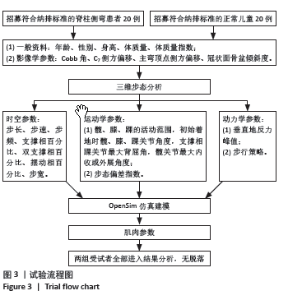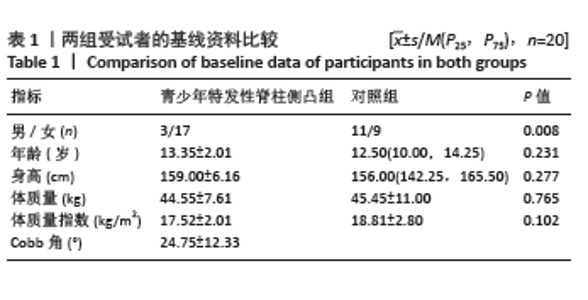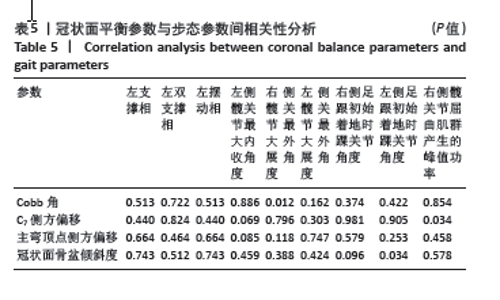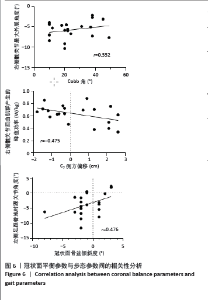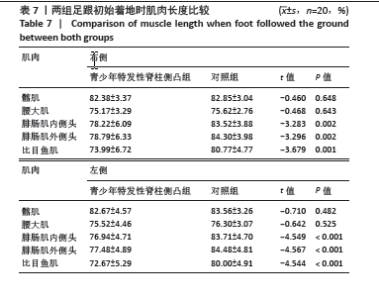Chinese Journal of Tissue Engineering Research ›› 2025, Vol. 29 ›› Issue (21): 4477-4485.doi: 10.12307/2025.819
Previous Articles Next Articles
Correlation of gait parameters and muscle parameters with imaging in adolescent idiopathic scoliosis patients
Liu Jing1, Xu Chunxin2, Lu Yangyang2, Qu Qinquan2, Zhu Qi1, Guo Yulan1, Shen Min1, 2
- 1School of Rehabilitation Medicine, Shanghai University of Traditional Chinese Medicine, Shanghai 201203, China; 2Shanghai Rehabilitation Center for Special Children, Shanghai 200127, China
-
Received:2024-04-08Accepted:2024-08-23Online:2025-07-28Published:2024-12-05 -
Contact:Shen Min, MS, Master’s supervisor, Chief physician, School of Rehabilitation Medicine, Shanghai University of Traditional Chinese Medicine, Shanghai 201203, China; Shanghai Rehabilitation Center for Special Children, Shanghai 200127, China -
About author:Liu Jing, Master candidate, School of Rehabilitation Medicine, Shanghai University of Traditional Chinese Medicine, Shanghai 201203, China -
Supported by:Health Management Research Fund Project of Shanghai Rehabilitation Medicine Association, No. 2023JGKT31 (to SM)
CLC Number:
Cite this article
Liu Jing, Xu Chunxin, Lu Yangyang, Qu Qinquan, Zhu Qi, Guo Yulan, Shen Min. Correlation of gait parameters and muscle parameters with imaging in adolescent idiopathic scoliosis patients[J]. Chinese Journal of Tissue Engineering Research, 2025, 29(21): 4477-4485.
share this article
Add to citation manager EndNote|Reference Manager|ProCite|BibTeX|RefWorks

2.4.2 运动学参数 比较两组在自然行走状态下的运动学参数(髋、膝、踝的活动范围,初始着地时髋、膝、踝关节角度,支撑相踝关节最大背屈角及髋关节最大内收或外展角度)发现,青少年特发性脊柱侧凸组患者左侧髋关节最大内收角度大于对照组,双侧髋关节最大外展角度明显小于对照组,差异均有显著性意义(P < 0.05);两组双侧足跟初始着地时踝关节角度相比差异有显著性意义 (P < 0.05),见表3。 2.4.3 动力学参数 比较两组在承重反应期和蹬离期的垂直地反力峰值,组间差异均无显著性意义(P > 0.05),见图4。 2.4.4 步行策略 比较两组在自然行走状态下的步行策略(踝关节蹬离地面时足跖屈肌群产生的峰值功率、髋关节屈曲肌群产生的峰值功率和推进策略统称为步行策略)发现,右侧髋关节屈曲肌群产生的峰值功率(H3)差异有显著性意义(P < 0.05),但双侧踝关节蹬离地面时足跖屈肌群产生的峰值功率(A2)和推进策略差异均无显著性意义 (P > 0.05),见图5。"

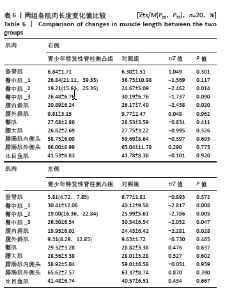
2.6 肌肉长度变化模拟计算结果 肌肉长度变化是指在步行周期内肌纤维最大长度与最小长度之差,差值大小在一定程度上反映了关节的活动范围及肌纤维的活动状态。此次研究选取的肌肉均根据缩放后的静态长度进行标准化,结果以百分比表示。根据表6可知,与对照组相比,青少年特发性脊柱侧凸组臀中肌肌纤维长度变化均变小,差异有显著性意义(P < 0.05)。此外,青少年特发性脊柱侧凸组患者双侧腹内斜肌肌纤维长度变化减少,差异有显著性意义(P < 0.05)。另外,比较两组受试者在足跟初始着地时的肌纤维长度发现,青少年特发性脊柱侧凸患者足跟初始着地时腓肠肌内外侧头和比目鱼肌的肌纤维长度均变短,差异有显著性意义(P < 0.05),见表7。 2.7 不良事件 试验中贴放在皮肤的表面标记物为黏性材质,出现皮肤过敏情况概率极低。"

| [1] ADDAI D, ZARKOS J, BOWEY AJ. Current concepts in the diagnosis and manage-ment of adolescent idiopathic scoliosis. Childs Nerv Syst. 2020;36(6):1111-1119. [2] WEINSTEIN SL, DOLAN LA, CHENG JC, et al. Adolescent idiopathic scoliosis. Lancet. 2008;371(9623):1527-1537. [3] HORNE JP, FLANNERY R, USMAN S. Adolescent idiopathic scoliosis: diagnosis and management. Am Fam Physician. 2014;89(3):193-198. [4] NEGRINI S, DONZELLI S, AULISA AG, et al. 2016 SOSORT guidelines: orthopaedic and rehabilitation treatment of idiopathic scoliosis during growth. Scoliosis Spinal Disord. 2018;13:3. [5] SUNG S, CHAE HW, LEE HS, et al. Incidence and Surgery Rate of Idiopathic Scoliosis: A Nationwide Database Study. Int J Environ Res Public Health. 2021;18(15):8152. [6] 陈梦婕,罗义,马琪超,等.青少年特发性脊柱侧弯的冠状位平衡与足底压力的相关性[J].中华全科医学,2020,18(4):542-546. [7] PENG Y, WANG SR, QIU GX, et al. Research progress on the etiology and pathogenesis of adolescent idiopathic scoliosis. Chin Med J (Engl). 2020;133(4):483-493. [8] ALTAF F, GIBSON A, DANNAWI Z, et al. Adolescent idiopathic scoliosis. BMJ. 2013;346:f2508. [9] DANIELSSON AJ, ROMBERG K, NACHEMSON AL. Spinal range of motion, muscle endurance, and back pain and function at least 20 years after fusion or brace treatment for adolescent idiopathic scoliosis: a case-control study. Spine (Phila Pa 1976). 2006;31(3): 275-283. [10] 刘依琳,李伊,杨华清,等.特发性脊柱侧凸手术治疗后肺功能变化的研究现状[J].中国临床医生杂志,2023,51(3):279-283. [11] SCHWENDER JD, DENIS F. Coronal plane imbalance in adolescent idiopathic scoliosis with left lumbar curves exceeding 40 degrees: the role of the lumbosacral hemicurve. Spine (Phila Pa 1976). 2000; 25(18):2358-2363. [12] ROORDA LD, ROEBROECK ME, VAN TILBURG T, et al. Measuring activity limitations in walking: development of a hierarchical scale for patients with lower-extremity disorders who live at home. Arch Phys Med Rehabil. 2005;86(12):2277-2283. [13] MAHAUDENS P, BANSE X, MOUSNY M, et al. Gait in adolescent idiopathic scoliosis: kinematics and electromyographic analysis. Eur Spine J. 2009;18(4):512-521. [14] 王彦辉,陈学明,于振山,等. 步态分析在青少年特发性脊柱侧凸中的应用进展[J]. 中华骨科杂志,2016,36(5):307-313. [15] 宋云雅,郭锦丽,曹策.青少年特发性脊柱侧弯患者的三维步态特征研究[J].实用骨科杂志,2023,29(5):417-421. [16] HABER CK, SACCO M. Scoliosis: lower limb asymmetries during the gait cycle. Arch Physiother. 2015;5:4. [17] DARYABOR A, ARAZPOUR M, SHARIFI G, et al. Gait and energy consumption in adolescent idiopathic scoliosis: A literature review. Ann Phys Rehabil Med. 2017;60(2):107-116. [18] FORTIN C, GRUNSTEIN E, LABELLE H, et al. Trunk imbalance in adolescent idiopathic scoliosis. Spine J. 2016;16(6):687-693. [19] YAGI M, OHNE H, KONOMI T, et al. Walking balance and compensatory gait mechanisms in surgically treated patients with adult spinal deformity. Spine J. 2017;17(3):409-417. [20] 中国青少年脊柱侧凸筛查临床实践指南及路径指引[J].中华骨科杂志,2020,40(23):1574-1582. [21] MA Q, WANG L, ZHAO L, et al. Coronal Balance vs. Sagittal Profile in Adolescent Idiopathic Scoliosis, Are They Correlated? Front Pediatr. 2020;7:523. [22] 鲁德志,王金武,许金霞,等.特发性脊柱侧弯患者躯干倾斜角与脊柱Cobb角、冠状面平衡的相关性研究[J].中国康复,2021, 36(1):3-7. [23] THORSTENSSON A, NILSSON J, CARLSON H, et al. Trunk movements in human locomotion. Acta Physiol Scand. 1984;121(1):9-22. [24] WU KW, LU TW, LEE WC, et al. Whole body balance control in Lenke 1 thoracic adolescent idiopathic scoliosis during level walking. PLoS One. 2020;15(3):e0229775. [25] WU KW, LU TW, LEE WC, et al. Altered balance control in thoracic adolescent idiopathic scoliosis during obstructed gait. PLoS One. 2020;15(2):e0228752. [26] GARG B, GUPTA M, MEHTA N, et al. Influence of Etiology and Onset of Deformity on Spatiotemporal, Kinematic, Kinetic, and Electromyography Gait Variables in Patients with Scoliosis-A Prospective, Comparative Study. Spine (Phila Pa 1976). 2021;46(6):374-382. [27] 朱飞龙,张明,吴宇,等.青少年特发性脊柱侧弯患者足部姿势和步态特征的3D形态分析及生物力学评价[J].中国组织工程研究, 2021,25(33):5294-5300. [28] 刘丹,唐占英,肖静,等.青少年特发性脊柱侧凸症运动学研究[J].世界中医药,2016,11(1):97-101. [29] KIM DS, PARK SH, GOH TS, et al. A meta-analysis of gait in adolescent idiopathic scoliosis. J Clin Neurosci. 2020;81:196-200. [30] ISHIHARA M, HIGUCHI Y. Kinetic Relationships between the Hip and Ankle Joints during Gait in Children with Cerebral Palsy: A Pilot Study. J Phys Ther Sci. 2014;26(5):737-740. [31] PERRY J, BURNFIELD JM. Gait Analysis: Normal and Pathological Function. Slack. 2010. [32] DOI T, HARIMAYA K, MITSUYASU H, et al. Right thoracic curvature in the normal spine. J Orthop Surg Res. 2011;6:4. [33] SCHWARTZ MH, ROZUMALSKI A. The Gait Deviation Index: a new comprehensive index of gait pathology. Gait Posture. 2008;28(3): 351-357. [34] MA Q, LIN H, WANG L, et al. Correlation between spinal coronal balance and static baropodometry in children with adolescent idiopathic scoliosis. Gait Posture. 2020;75:93-97. [35] RACZKOWSKI JW, DANISZEWSKA B, ZOLYNSKI K. Functional scoliosis caused by leg length discrepancy. Arch Med Sci. 2010;6(3):393-398. [36] ROSE R, FUENTES A, HAMEL BJ, et al. Pediatric leg length discrepancy: causes and treatments. Orthop Nurs. 1999;18(2):21-29;30-31. [37] PRESCIUTTI SM, KARUKANDA T, LEE M. Management decisions for adolescent idiopathic scoliosis significantly affect patient radiation exposure. Spine J. 2014;14(9):1984-1990. [38] SIMONY A, HANSEN EJ, CHRISTENSEN SB, et al. Incidence of cancer in adolescent idiopathic scoliosis patients treated 25 years previously. Eur Spine J. 2016;25(10):3366-3370. [39] LUAN FJ, WAN Y, MAK KC, et al. Cancer and mortality risks of patients with scoliosis from radiation exposure: a systematic review and meta-analysis. Eur Spine J. 2020;29(12):3123-3134. [40] SIMONSEN EB. Contributions to the understanding of gait control. Dan Med J. 2014;61(4):B4823. [41] HUXEL BLIVEN KC, ANDERSON BE. Core stability training for injury prevention. Sports Health. 2013;5(6):514-522. |
| [1] | Fu Enhong, Yang Hang, Liang Cheng, Zhang Xiaogang, Zhang Yali, Jin Zhongmin. OpenSim-based prediction of lower-limb biomechanical behavior in adolescents with plantarflexor weakness [J]. Chinese Journal of Tissue Engineering Research, 2025, 29(9): 1789-1795. |
| [2] | Miao Jiahang, Ma Sheng, Li Qupeng, Yu Huilin, Hu Tianyu, Gao Xiao, Feng Hu. Cervical lordosis ratio can be used as a decision-making indicator for selection of posterior surgical approach for multi-level cervical spondylotic myelopathy [J]. Chinese Journal of Tissue Engineering Research, 2025, 29(9): 1796-1802. |
| [3] | Wen Zixing, Xu Xin, Zhu Shengqun. Correlations between gastrocnemius morphology parameters and physical activity capacity in elderly females under high-frequency ultrasound [J]. Chinese Journal of Tissue Engineering Research, 2025, 29(5): 1058-1063. |
| [4] | Li Chen, Liu Ye, Ni Xindi, Zhang Yuang. Simulation analysis of real-time continuous stiffness in muscle fibers and tendons of the triceps surae during multi-joint movement [J]. Chinese Journal of Tissue Engineering Research, 2025, 29(35): 7529-7536. |
| [5] | Ye Xiaolong, Zhang Yuxuan, Fu Rongchang, Liu Yun, Yusanjiang·Wuhuer, Escar·Aimer, Ma Yuan. A three-dimensional finite element modal analysis on adolescent idiopathic scoliosis [J]. Chinese Journal of Tissue Engineering Research, 2025, 29(33): 7072-7079. |
| [6] | Wang Simin, Zhang Dezhou, Zhao Jing, Wang Chaoqun, Li Kun, Chen Jie, Bai Xue, Zhao Hailong, Zhang Shaojie, Ma Yuan, Hao Yunteng, Yang Yang, Li Zhijun, Shi Jun, Wang Xing. Artificial intelligence and cervical spine image recognition: application prospects and challenges [J]. Chinese Journal of Tissue Engineering Research, 2025, 29(33): 7231-7240. |
| [7] | Zhang Bochun, Li Wei, Li Guangzheng, Ding Haoqin, Li Gang, Liang Xuezhen, . Association between neuroimaging changes and osteonecrosis: a large sample analysis from UK Biobank and FinnGen databases [J]. Chinese Journal of Tissue Engineering Research, 2025, 29(30): 6574-6582. |
| [8] | Song Haoran, Zhang Yuqiang, Gu Na, Zhi Xiaodong, Wang Wei. Visualization analysis of artificial intelligence in bone trauma research based on Citespace [J]. Chinese Journal of Tissue Engineering Research, 2025, 29(3): 493-502. |
| [9] | Zheng Xiaodong, Gao Shan, Han Wenjin, Liu Lijun, Jia Menglong, Yu Longtan. Visual analysis of treatment of adolescent idiopathic scoliosis [J]. Chinese Journal of Tissue Engineering Research, 2025, 29(3): 645-653. |
| [10] | Chen Senlin, Zhu Zhou, Wan Qianbing. Application of Janus micro/nanoparticles in biomedicine [J]. Chinese Journal of Tissue Engineering Research, 2025, 29(28): 6101-6109. |
| [11] |
Wang Qianliang, Zhang Qianzhongyi, Peng Yujian, Yan Jun.
Effects of unilateral biportal endoscopic transforaminal lumbar interbody fusion on paraspinal muscles
[J]. Chinese Journal of Tissue Engineering Research, 2025, 29(27): 5862-5868.
|
| [12] | Zhang Juanjuan, Jiang Nannan, Wu Yajun, Gu Qian, He Linfei, Ji Yongxin, Liu Su. Schroth therapy combined with core strength training improves scoliosis angle in patients with mild adolescent idiopathic scoliosis [J]. Chinese Journal of Tissue Engineering Research, 2025, 29(27): 5876-5882. |
| [13] | Liu Jiashun, Xie Hongru, Sun Yunkai, Li Shujin, Mao Tengfei, An Yaoyao, Zhang Qin. Correlation and mechanism between lumbar disc degeneration and paraspinal muscle changes [J]. Chinese Journal of Tissue Engineering Research, 2025, 29(27): 5897-5906. |
| [14] | Dai Jieting, Ren Bihui, Xu Yehao, Guo Shuigen, Wei Hongwu. Reactive soft tissue preservation combined with demineralized dentin matrix for extraction site preservation [J]. Chinese Journal of Tissue Engineering Research, 2025, 29(17): 3557-3565. |
| [15] | Gui Bin, Jiang Nan, Huang Xin, Zhong Fanglu, Wang Zhiwen, Liu Qianhui, Guo Yuxin, Chen Yueying, Pu Huan, Deng Qing. Application of nanoprobe based on aggregation-induced luminescence in photothermal diagnosis and treatment of prostate cancer [J]. Chinese Journal of Tissue Engineering Research, 2025, 29(16): 3400-3409. |
| Viewed | ||||||
|
Full text |
|
|||||
|
Abstract |
|
|||||
